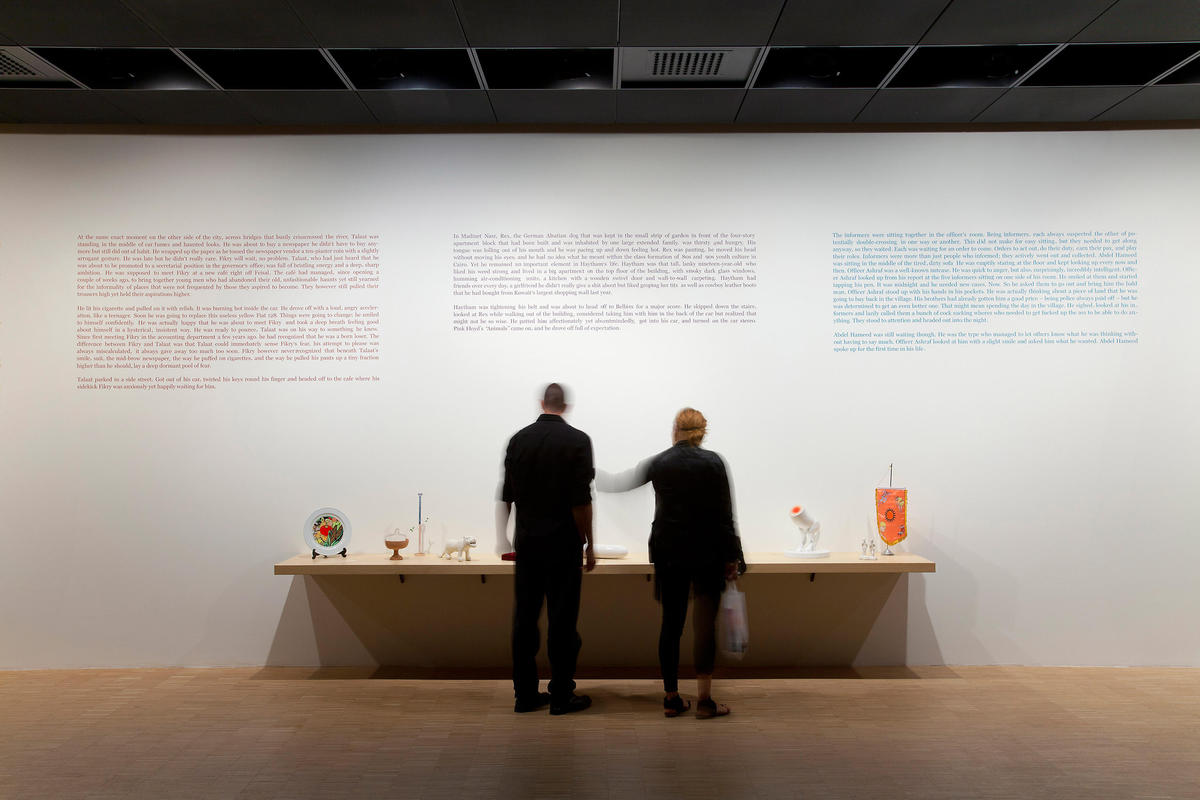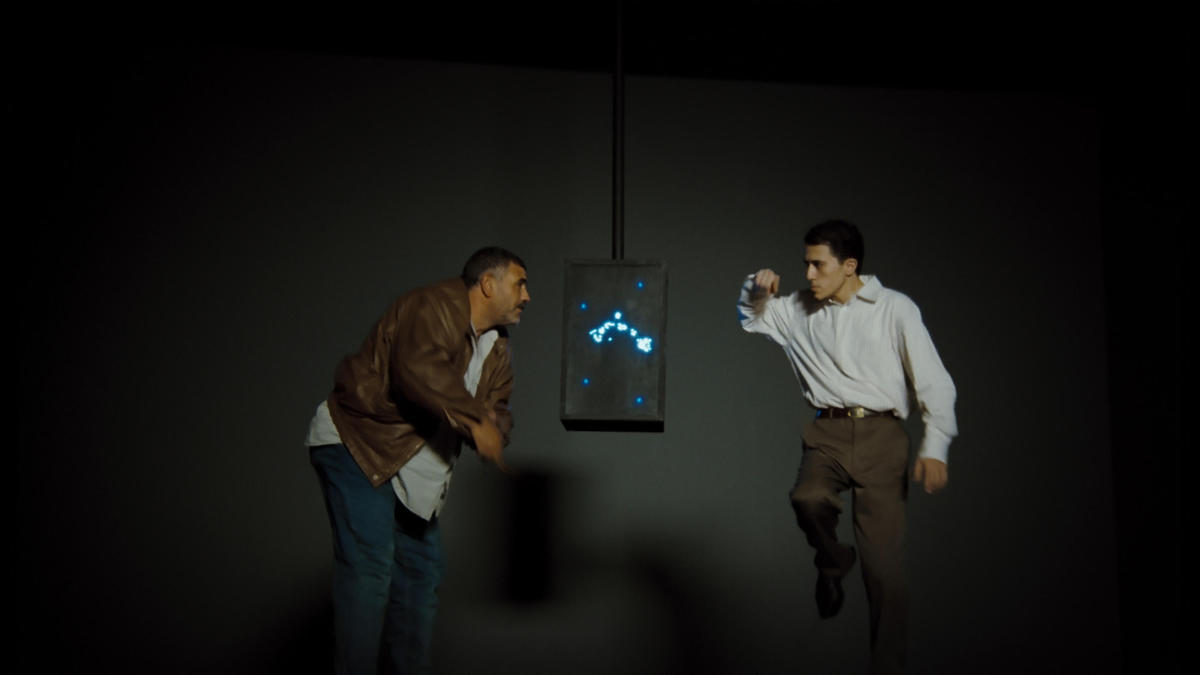
Istanbul
Hassan Khan
SALT Beyoğlu
September 21, 2012–January 6, 2013
At SALT’s recent exhibition of nearly two decades of Hassan Khan’s work, some thirty-one artworks in a wide range of media — including photos, films, music, and objects — were held in balanced tension across three floors. With formal and thematic relays crisscrossing in every direction, the show dexterously slipped the grasp of linear chronology and the rule of personal beginnings, middles, and ends. This prying loose of the retrospective format from biographical time kept the figure of the artist himself at bay: Khan ended up more of a hazy silhouette on the horizon than a clear-cut figure we might pretend to know or understand well by the end of the show.
In this, the exhibition’s structure mirrors one of Khan’s signature approaches as an artist (and writer, and musician, and all the many in-between roles that he occupies). Khan doesn’t shirk the biographical; in fact, he mines it as one of the most substantial modes through which we produce meaning. And yet, he takes up some of the most cliché-ridden means of expressing the subjective “I” — dreams, first-person narratives, evocations of childhood objects and experiences — precisely in order to channel them elsewhere.
SALT’s curatorial team worked closely with the artist during the exhibition’s preparation, and I imagine that’s a major reason for the strong parallels between the logic of the works and the exhibition’s distinctive structure. (The text on the website, for instance, is credited as a collaboration, and the exhibition texts as a whole sometimes read as a defensive effort to avoid anything that could be construed as remotely explanatory.) Of course, this raises the question of artists’ involvement with institutions in crafting their own backstories for public consumption. But there are some even more basic questions that viewing Khan’s work all together makes suddenly pressing — what do we hope, more generally, to get out of taking a retrospective view in the first place? In what unique ways do given artists, and Khan in particular, benefit from being seen retrospectively?
Almost every conversation I had about the exhibition this October involved comments about Khan’s enviable ability to move across a wide variety of media while, somewhat miraculously, managing to maintain a deep-seated consistency. The retrospective is framed by two heavily musical works rooted in Khan’s own work as a musician. The short film Jewel (2010) appears on the first of three floors: the pattern of a deep-sea fish’s twinkling path transforms into a glowing lantern of punctured metal, which in turn illuminates two men — one round and jeans-clad, the other rail-thin and in bureaucratic chic — dancing, awkwardly if not enthusiastically, to a pressing shaabi beat. At the culmination of the show is DOM-TAK-TAK-DOM-TAK (2005), a project realized in the recording studio: first, the choice of several Egyptian shaabi tracks, a popular genre that at least one critic has described as “as impassioned as it is generic,” followed by a collaboration with musicians to suss out commonly used shaabi rhythms, which were then rerecorded, improvised over, mixed, and remixed. A lot of the artist’s most essential concerns come together in these two major works — in particular an effort to make elaborately choreographed sequences appear as real time in both music and video — and this may be the Khan with whom most casual followers are familiar. It is certainly the Khan of The Hidden Location (2004) and Muslimgauze R.I.P. (2010), both films that hinge on similar temporal acts of improvisation, narrative setting, and editing.
It is possible that his work is singularly well served by the retrospective format at least in part because there always seems to be a missing key to one artwork lodged within another, even across decades. There are, too, plenty of instances of plain cross-reference. Evidence of Evidence I (2010) is probably the most straightforward: the artist reproduces fragments of previous works (originally photographs, printed pages, performance documents) as etchings, twenty-six small prints with the atmospheric blurring of intaglio and the palpable involvement of a hand. As in much of his work, it’s easy to sense the deliberateness of Khan’s formal choice — here, one calibrated to make the reproduced fragments something profoundly new while triggering a process of half-recollections and connections on the part of the viewer.
Other times, links between artworks are not predesignated but lie in the common ways they encourage the viewer to feel their way along. For example, one might need the linguistic lessons of the video The Dead Dog Speaks (2010) to feel at home with a text-based piece like Insecure (2002). Language is a major preoccupation for Khan. It’s often the social-ness of language, its implication within and creation of an implied social world, that he presses. The Dead Dog Speaks is a four-minute video in which three computer-generated figures float and bounce gently on a red ground — a woman in a full-length coat, the disembodied head of a mustached man, a long-haired lapdog. The trio emit a rapid-fire series of words and short phrases in Arabic, but the voices we hear are often mismatched. “Me,” “You,” “Who,” they begin, as English subtitles scroll quickly and the figures bounce and slide gently into new positions on the screen, triggered by the force of their exclamations. One feels, suddenly, the extraordinary capacity of even the most minimal fragments of language to plot out an entire situation: individuals, their relative positions, a social space within which we are also implicated as thinking viewers. Not unlike The Dead Dog Speaks, the admonitions of Insecure prod us into an awareness of how we project ourselves, often through the simple social cipher of a gesture. A series of instructions are printed on the wall: “list 10 strategies you use to seduce others”; “whisper your name over and over until it doesn’t make sense”; “while in conversation closely watch the person you’re speaking with and start to assign meanings to their gestures.”
What would these artworks look like outside of a retrospective? It may seem wildly obvious to note that works function differently when they stand alone or travel to different contexts, but the shape of Khan’s oeuvre — as deeply systematic in its own right as it is concerned with the systematic ways we ourselves communicate, narrate, and produce — provides us with an opportunity to take this question seriously. About halfway through, for example, there’s a sequence where the exhibition doesn’t quite hold together; one too many photos, collages, text-based works, performance documents, and drawings are marched down a wall. And when the tension lapses, one feels how tightly Khan’s formal and conceptual ethos functions elsewhere, in individual works and in the curatorial framing alike.
Khan strikes a new note with a handful of object-based works from the past three years, distributed relatively evenly across the exhibition. (It would be interesting to know if Khan did any object-based work earlier than 2010.) Twist (2012), a metal rod with a single curve in the middle, is intended to pinpoint a “non-functional moment when human civilization distinguishes itself.” Banque Bannister (2010) is an exact replica of the original bannister of the Banque Misr in downtown Cairo. A third, The Agreement (2011), pairs five short stories of Khan’s invention with ten enigmatic objects that he had manufactured — a half-crystal, half-clay vessel, a pencil-thin metal rod sharpened to a point at either end, a smooth white ceramic capsule. Perhaps more than any of his other output, these three pieces carry with them the risk of being viewed as manifestations of a regional material vernacular, something particularly valued by a contemporary biennial culture hungry for easy signifiers of cultural specificity. This isn’t a criticism, or to say that this is Khan’s motivation, but just that, as manufactured objects with material heft, this strain of his oeuvre confronts a set of debates about authenticity in a palpably different mode than his films or photographs.
In fact, one of the major revelations for me was Khan the photographer. The medium’s “natural” engagement with personal memory, its implication of an implied archive beyond its bounds, its modes of fragmentation and formal manipulation, all movingly intersect with Khan’s broader concerns, where his objects left me cold. Lust (2008) was a standout: a series of fifty crepuscular, framed cellphone photographs, cropped scenes of anonymous room interiors, a hand on a mirror, figures pressing forward out of a crowd. Triangulating Lust with Alphabet Book (2006), where Khan created blurred, visceral images sourced from his own dreams, and Photographs of statues owned by the artist (2010), three large prints of small souvenir figurines, had me wishing there were a sustained essay on this aspect of his work.
In the end, Khan’s strategies of ambiguation can be discomfiting, and probably because of his close involvement in the retrospective’s organization, the viewer isn’t always offered an alternate angle from which to apprehend his work. The artist hands a lot of responsibility over to the viewer — a gesture that could be read alternately as generous or obscurantist. Either way, it constitutes a particular way of taking seriously the dictum that the task of the artist is to function publicly in some way. Khan’s retrospective is not traveling, nor is there a catalog, and it’s regretful that SALT missed an opportunity to show the work beyond Istanbul, or to produce some sustained critical writing in and around it. The simple act of moving these objects elsewhere, adjusted to a different physical space, or into alternate formats such as a catalog, could only continue to pressure that question of the diverse lives artworks may have.
